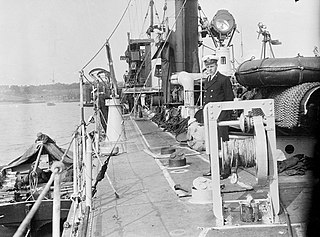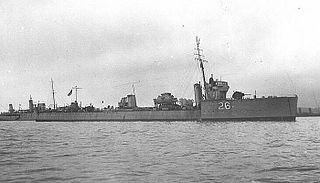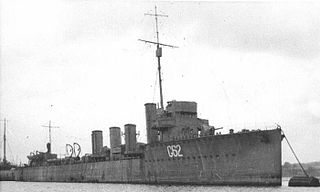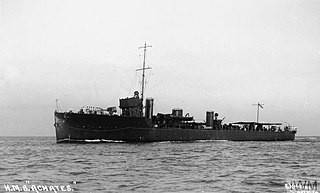War service
Originally ordered by Chile, Tipperary and her sisters were bought by the Royal Navy at the outbreak of World War I. Initially, Tipperary served as the second flotilla leader with the 3rd Destroyer Flotilla in the Harwich Force, arriving there in June 1915. [1] Late in that same year, she took charge of a detachment of destroyers from the 2nd Flotilla, [2] while in March 1916, Tipperary had rejoined the Harwich Force, being attached to the Fifth Light Cruiser Squadron. [3]
For a while during the war, she was commanded by Captain (later Admiral) Sir Barry Domvile. [4]
In May 1916, Tipperary was made the leader of the 4th Flotilla, a formation which directly supported the Grand Fleet. [5]
Sinking
About 21:58 GMT on 31 May 1916, while 4th Destroyer Flotilla was searching for the German High Seas Fleet in the North Sea in the Battle of Jutland, she encountered the enemy's 7th Flotilla (destroyers). The Imperial German Naval vessels launched torpedoes at the British ships, none of which hit, and 7th Flotilla then turned away. Nicholas Jellicoe's account states that "Between 23:15 and 23:20 a lookout [on HMS Garland] ... saw what he thought were enemy ships on the starboard quarter". [6] A few minutes later, Tipperary flashed the recognition signal and was immediately lit up by the searchlights of three German battleships and three light cruisers. [7] From 23:30 to about 23:34, around 150 5.9-inch shells from SMS Westfalen and SMS Nassau were fired at Tipperary; she was badly stricken by this fire, which left her bridge damaged and most of her forward crew casualties, including her commander, Captain Wintour. At about 02:00 GMT on 1 June 1916, she was abandoned and sank in the following hours due to battle damage. [8] 150 of her crew of 197 were killed in the action, a number of the survivors were rescued from the sea by the Imperial German Navy and transported back to Germany as prisoners of war.
Stoker David Eunson described the sinking: "As we floated away on that awful night, many died of sheer exhaustion and suffering. After drifting for well nigh 5 hours we were picked up at dawn. I saw the Tipperary, a mass of flames, keel over". [9]

HMS Ambuscade was an Acasta-class destroyer of the Royal Navy and was launched in 1913. She served throughout the First World War, forming part of the Grand Fleet and taking part at the Battle of Jutland, serving in the Dover Patrol and spending the latter part of the war as a convoy escort. She was sold for scrapping in 1921.
HMS Ossory was an Admiralty M-class destroyer built for the Royal Navy during the First World War. She took part in the Battle of Jutland in 1916 and was sold for scrap in 1921.

HMS Lance was a Laforey-class destroyer of the Royal Navy. Launched a few months before the outbreak of the First World War and attached to the Harwich Force, Lance took part in several engagements during the war, including the sinking of the Königin Luise and the Battle off Texel. She was responsible for firing the first British shot of the war.

HMS Laforey was the lead ship of her class of destroyer built for the Royal Navy. Launched a year before the First World War began, she was attached to the Dover Patrol. Laforey saw action in several engagements with German torpedo boats, including the Battle off Noordhinder Bank and the action of 17 March 1917. Laforey was sunk in 1917 by a British mine after escorting several freighters to France. She was named for Francis Laforey, captain of HMS Spartiate at the Battle of Trafalgar in 1805.

The Active-class cruisers were a trio of scout cruisers built for the Royal Navy shortly before the First World War. They were initially assigned to the First Fleet and became destroyer flotilla leaders in 1914. Amphion and Fearless and their flotillas were assigned to the Harwich Force when the war began in August 1914. They went out on a patrol on the first day of the war and Amphion and her destroyers encountered and sank a German minelayer. On the voyage home, the cruiser struck a mine laid by the German ship and sank. She was the first ship of the Royal Navy to be sunk in the war.

HMS Active was the name ship of her class of three scout cruisers built for the Royal Navy in the 1910s. Completed in 1911, she was briefly assigned to several different units until the ship became the flotilla leader of the 2nd Destroyer Flotilla (DF) in 1914. When the First World War began in August of that year, the 2nd DF was assigned to the Grand Fleet where their primary task was to protect the fleet from submarines.

HMS Bellona was one of two Boadicea-class scout cruisers built for the Royal Navy in the first decade of the 20th century. The ship served as the flotilla leader for the 2nd Destroyer Flotilla from her completion in 1910 until 1913 when she was transferred to the 1st Battle Squadron. Bellona spent the bulk of World War I with that squadron. She was present at, but did not fight in, the Battle of Jutland in mid-1916. The ship was converted into a minelayer in mid-1917 and made four sorties to lay her mines before the end of the war. Bellona was reduced to reserve in 1919 and sold to be broken up for scrap in 1921.

HMS Boadicea was the lead ship of her class of scout cruisers built for the Royal Navy in the first decade of the 20th century. She led the 1st Destroyer Flotilla from completion until the ship was transferred to the 3rd Destroyer Flotilla in mid-1912. A year later Boadicea was reassigned to the 2nd Battle Squadron and she spent the bulk of World War I with that squadron. The ship was present at, but did not fight in, the Battle of Jutland in mid-1916. Boadicea was converted into a minelayer at the end of 1917 and made three sorties to lay her mines before the end of the war. She was placed in reserve after the war and taken out of service in 1920. The ship was used for harbour service at Dartmouth until she was sold for scrap in 1926.
Chios was a Medea-class destroyer laid down for the Greek Navy by Fairfield Shipbuilding and Engineering Company, Govan in 1914. She was launched as 16 December 1914 and completed for service in the Royal Navy as HMS Melampus on 29 June 1915. On 16 April 1917 she accidentally rammed and sank the C-class submarine C16. She was sold for breaking up on 22 September 1921.
HMS Ophelia was an Admiralty M-class destroyer built for the Royal Navy during the First World War, entering service in 1916. The ship served at the Battle of Jutland on 31 May/1 June 1916, and sank a German submarine in 1918. She was sold for scrap in 1921.

HMS Porpoise was an Acasta-class destroyer of the Royal Navy, which was built by Thornycroft between 1912 and 1914. Porpoise served through the First World War, taking part at the Battle of Jutland in 1916, where she was damaged. In 1920, she was sold to the Brazilian Navy serving under the name Alexandrino de Alencar and was renamed Maranhão in 1927. Maranhão remained in service when Brazil entered the Second World War, being used for patrol and convoy duties. She was disposed of in 1945.
HMS Laverock was a Laforey-class destroyer of the Royal Navy. She was launched in 1913 and entered service in October 1914. Laverock served through the First World War, operating with the Harwich Force and in the English Channel. She was sold for scrap in 1921.

HMS Cockatrice was an Acasta-class destroyer of the British Royal Navy. She was built by Hawthorn Leslie and Company, launching in 1912 and served throughout the First World War. She was sold for scrap in 1921.

HMS Marksman was a Marksman-class flotilla leader of the British Royal Navy. Construction at Hawthorn Leslie's Newcastle upon Tyne shipyard began in 1914, shortly before the outbreak of the First World War, and the ship was launched and completed in 1915. She took part in the Battle of Jutland in 1916 and survived the war. She was sold for scrap in 1921.
HMS Lightfoot was a Marksman-class flotilla leader of the British Royal Navy. Construction by J. Samuel White began in June 1914, shortly before the outbreak of the First World War, and the ship was launched and completed in 1915. She survived the war and was sold for scrap in 1921.
HMS Christopher was an Acasta-class destroyer of the British Royal Navy. She was built by Hawthorn Leslie in 1911–1912. She served throughout the First World War, forming part of the Grand Fleet until 1916 and taking part in the Battle of Jutland. Later in the war she served in the English Channel to protect merchant shipping against attacks by German U-boats. Christopher was sold for scrap in May 1921.

HMS Kempenfelt was a Marksman-class flotilla leader of the British Royal Navy. She was built by the Cammell Laird at their Birkenhead shipyard, with construction starting in 1914 and completed in August 1915. She served through the remainder of the First World War. She was sold for scrap in 1921.

HMS Landrail was a Laforey-class destroyer of the British Royal Navy. The Laforey class was the class of destroyers ordered under the Royal Navy's 1912–1913 construction programme, which were armed with three 4-inch (102 mm) guns and four torpedo tubes and were capable of 29 knots. The ship, which was originally to be named Hotspur but was renamed before launch, was built by the Scottish shipbuilder Yarrow between 1912 and 1914,

HMS Achates was an Acasta -class destroyer of the British Royal Navy. She was built by the Scottish shipbuilder John Brown and was built between 1912 and 1913. Like all Acasta-class destroyers, Achates was armed with three 4-inch (102 mm) guns and two torpedo tubes, with a specified speed of 29 knots.

HMS Lawford was a Laforey-class destroyer of the British Royal Navy. The Laforey class was the class of destroyers ordered under the Royal Navy's 1912–1913 construction programme, which were armed with three 4-inch (102 mm) guns and four torpedo tubes and were capable of 29 knots. The ship, which was originally to be named Ivanhoe but was renamed before launch, was built by the Scottish shipbuilder Fairfields between 1912 and 1914.














